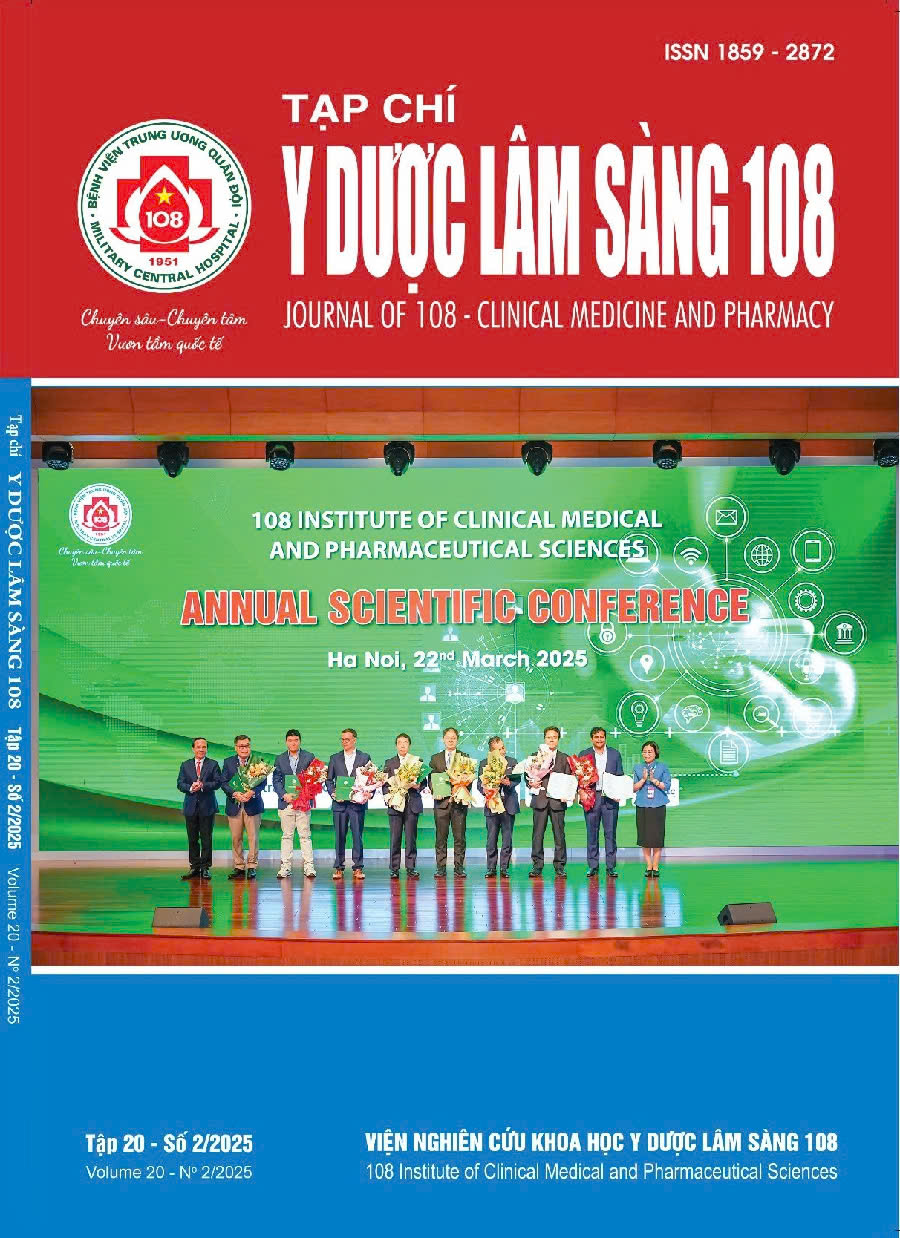Vai trò của stent tụy trong dự phòng biến chứng viêm tụy cấp sau ERCP khi có sự tác động vào ống tụy
Main Article Content
Keywords
Tóm tắt
Mục tiêu: Đánh giá vai trò của đặt stent tụy trong dự phòng biến chứng viêm tụy cấp sau ERCP khi có sự tác động vào ống tụy. Đối tượng và phương pháp: Hồi cứu 298 bệnh nhân có chỉ định can thiệp ERCP điều trị tắc mật, viêm đường mật có sự tác động vào ống tụy (bơm cản quang, hoặc đưa guidewire vào ống tụy) tại Bệnh viện TƯQĐ 108 từ 01/2021 đến 03/2024. Chia làm 2 nhóm: Không đặt stent tụy (128 bệnh nhân) và đặt stent tụy (170 bệnh nhân). Kết quả: Các đặc điểm về tuổi, giới tính không có sự khác biệt đáng kể giữa hai nhóm. Stent tụy liên quan chặt chẽ tới giảm nguy cơ viêm tụy cấp sau ERCP (tỷ lệ viêm tụy cấp ở bệnh nhân không đặt stent tụy vs đặt stent tụy là 41,2% vs 21,9%; OR = 0,4; p=0,0005). Khi tăng men tụy sau ERCP, stent tụy cũng giúp làm giảm đáng kể nguy cơ diễn tiến thành viêm tụy cấp (OR = 0,17; p<0,0001). Tỷ lệ biến chứng khác như chảy máu diện cắt, nhiễm khuẩn, thủng tương đương giữa 2 nhóm. Biến chứng di lệch stent tụy rất hiếm gặp (0,8%). Kết luận: Đặt stent tụy là một biện pháp hiệu quả và an toàn trong dự phòng viêm tụy cấp sau ERCP ở các bệnh nhân có nguy cơ cao, giúp giảm tỷ lệ biến chứng và cải thiện kết quả điều trị.
Article Details
Các tài liệu tham khảo
2. Freeman ML, DiSario JA, Nelson DB et al (2001) Risk factors for post-ERCP pancreatitis: A prospective, multicenter study. Gastrointest Endosc 54(4): 425-34. doi: 10.1067/mge.2001.117550.
3. Ribeiro IB, do Monte Junior ES, Miranda Neto AA, et al (2021) Pancreatitis after endoscopic retrograde cholangiopancreatography: A narrative review. World J Gastroenterol 7(20): 2495-2506. doi:10.3748/wjg.v27.i20.2495.
4. Akshintala VS, Kanthasamy K, Bhullar FA et al (2023) Incidence, severity, and mortality of post-ERCP pancreatitis: an updated systematic review and meta-analysis of 145 randomized controlled trials. Gastrointest Endosc 98(1): 1-6 e12. doi:10.1016/j.gie.2023.03.023.
5. Phillip V, Pukitis A, Epstein A et al (2019) Pancreatic stenting to prevent post-ERCP pancreatitis: a randomized multicenter trial. Endosc Int Open 7(7): 860-868. doi:10.1055/a-0886-6384.
6. Cotton PB, Lehman G, Vennes J et al (1991) Endoscopic sphincterotomy complications and their management: An attempt at consensus. Gastrointest Endosc 37(3): 383-393. doi:10.1016/s0016-5107(91)70740-2.
7. Freeman ML, Nelson DB, Sherman S et al (1996) Complications of endoscopic biliary sphincterotomy. N Engl J Med 335(13): 909-918. doi:10.1056/NEJM199609263351301.
8. Ito K, Fujita N, Noda Y et al (2007) Efficacy and safety of prophylactic pancreatic duct stent (pit-stent) placement in patients at high risk of post-ercp pancreatitis. Digestive Endoscopy 19(3): 130-133. doi:https://doi.org/10.1111/j.1443-1661.2007.00743.x.
 ISSN: 1859 - 2872
ISSN: 1859 - 2872
